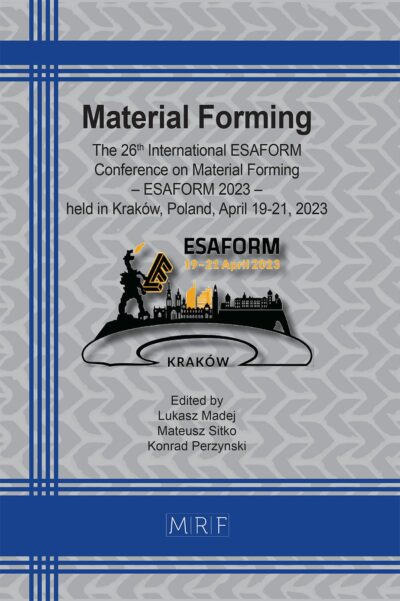–
A strategy for minimizing the computational time of simulations involving near-surface embossing of sheet metal materials
HEINZELMANN Pascal, GÖRZ Marcel, RIEDMÜLLER Kim Rouven, LIEWALD Mathias
download PDFAbstract. By near-surface embossing, work hardening can be introduced into sheet metal blanks, thus increasing the material´s yield strength. Hence, this property-modifying process can be used to improve the lightweight potential of a component on the one hand and its crash performance on the other. For the early design of such embossing or forming processes and to predict the modification of the material properties, FE modelling is currently used. Here, the embossing of the near-surface structures is usually simulated first, followed by the forming process. However, existing simulation methods are time-consuming and computationally intensive, due to the simulation of the whole embossing process. For this purpose, this paper presents two approaches for improving the simulation time of embossing and forming processes. Compared to the conventional holistic embossing and forming simulation, these approaches are based on a new mapping strategy and experimental data. In the mapping variant, solid elements’ stress and strain distribution is mapped to shell elements, thus including the embossing history for the forming simulation. For the experimental-based variant, the yield curves of embossed tensile tests are determined and used to approximate the property changes in the simulation. Both concepts are compared with each other and the conventional simulation method in terms of accuracy and calculation time. This paper finally shows that simulation can be performed faster with the new approaches than with the current sequential modelled workflow.
Keywords
Embossing, Dual-Phase Steel, Simulation, Mapping
Published online 4/24/2024, 9 pages
Copyright © 2024 by the author(s)
Published under license by Materials Research Forum LLC., Millersville PA, USA
Citation: HEINZELMANN Pascal, GÖRZ Marcel, RIEDMÜLLER Kim Rouven, LIEWALD Mathias, A strategy for minimizing the computational time of simulations involving near-surface embossing of sheet metal materials, Materials Research Proceedings, Vol. 41, pp 2262-2270, 2024
DOI: https://doi.org/10.21741/9781644903131-249
The article was published as article 249 of the book Material Forming
![]() Content from this work may be used under the terms of the Creative Commons Attribution 3.0 license. Any further distribution of this work must maintain attribution to the author(s) and the title of the work, journal citation and DOI.
Content from this work may be used under the terms of the Creative Commons Attribution 3.0 license. Any further distribution of this work must maintain attribution to the author(s) and the title of the work, journal citation and DOI.
References
[1] K. Shanmugam, V. Gadhamshetty, P. Yadav, D. Athanassiadis, M. Tysklind, and V. K. Upadhyayula, “Advanced High-Strength Steel and Carbon Fiber Reinforced Polymer Composite Body in White for Passenger Cars: Environmental Performance and Sustainable Return on Investment under Different Propulsion Modes,” ACS Sustainable Chem. Eng., vol. 7, no. 5, pp. 4951–4963, 2019. https://doi.org/10.1021/acssuschemeng.8b05588
[2] H. E. Friedrich, Leichtbau in der Fahrzeugtechnik. Wiesbaden: Springer Fachmedien Wiesbaden, 2017.
[3] C. S. Namoco, T. Iizuka, R. C. Sagrado, N. Takakura, and K. Yamaguchi, “Experimental and numerical investigation of restoration behavior of sheet metals subjected to bulging deformation,” Journal of Materials Processing Technology, vol. 177, 1-3, pp. 368–372, 2006. https://doi.org/10.1016/j.jmatprotec.2006.03.208
[4] C. S. Namoco, T. Iizuka, K. Narita, N. Takakura, and K. Yamaguchi, “Effects of embossing and restoration process on the deep drawability of aluminum alloy sheets,” Journal of Materials Processing Technology, vol. 187-188, pp. 202–206, 2007. https://doi.org/10.1016/j.jmatprotec.2006.11.182
[5] Y. Abe, K. Mori, T. Maeno, S. Ishihara, and Y. Kato, “Improvement of sheet metal formability by local work-hardening with punch indentation,” Prod. Eng. Res. Devel., vol. 13, no. 5, pp. 589–597, 2019. https://doi.org/10.1007/s11740-019-00910-6
[6] S. Walzer, M. Liewald, N. Simon, J. Gibmeier, H. Erdle, and T. Böhlke, “Improvement of Sheet Metal Properties by Inducing Residual Stresses into Sheet Metal Components by Embossing and Reforming,” Applied Science and Engineering Progress, vol. 15, no. 1, 2021. https://doi.org/10.14416/j.asep.2021.09.006
[7] D. Briesenick, S. Walzer, and M. Liewald, “Study on the Effect of Embossing on the Bending Properties of High-Strength Sheet Metals,” in Forming the Future: Proceedings of the 13th International Conference on the Technology of Plasticity (The Minerals, Metals & Materials Series), G. Daehn, J. Cao, B. Kinsey, E. Tekkaya, A. Vivek, and Y. Yoshida, Eds., 1st ed. Cham: Springer International Publishing; Imprint Springer, 2021, pp. 2585–2595
[8] P. Heinzelmann, D. Briesenick, and M. Liewald, “Characterization of the Mechanical Properties of Selectively Embossed Sheet Metal Materials Under Multi-Axial Loads,” IOP Conf. Ser.: Mater. Sci. Eng., vol. 1284, no. 1, p. 12043, 2023. https://doi.org/10.1088/1757-899X/1284/1/012043
[9] P. Heinzelmannn, D. Briesenick, and M. Liewald, “Modifying mechanical properties of sheet metal materials by work hardening mechanisms induced by selective embossing,” in Material Forming, Lukasz Madej, Mateusz Sitko, Konrad Perzynski, Ed., 2023, pp. 951–958. https://doi.org/10.21741/9781644902479-104
[10] E. Madenci, The Finite Element Method and Applications in Engineering Using ANSYS®, 2nd ed. (SpringerLink Bücher). Boston, MA: Springer, 2015.
[11] C. Liebold and A. Haufe, “process2product simulation: Closing Incompatibilities in Constitutive Modeling and Spatial Discretization with envyo®,” in Dearborn, Michigan, USA, 2018.
[12] Prüfung metallischer Werkstoffe – Zugproben, DIN 50125, DIN Deutsches Institut für Normung e. V., Berlin, 2022.
[13] Metallische Werkstoffe – Zugversuch: Teil 1: Prüfverfahren bei Raumtemperatur (ISO 6892-1:2019), DIN EN ISO 6892-1, DIN Deutsches Institut für Normung e. V., Berlin, 2020.
[14] Metallische Werkstoffe – Biegeversuch (ISO 7438:2020), DIN EN ISO 7438, DIN Deutsches Institut für Normung e. V., Berlin, 2021.
[15] A. R. Birkert, S. Haage, and M. Straub, Umformtechnische Herstellung komplexer Karosserieteile: Auslegung von Ziehanlagen. Berlin, Heidelberg: Springer Vieweg, 2013.
[16] J. E. Hockett and O. D. Sherby, “Large strain deformation of polycrystalline metals at low homologous temperatures,” Journal of the Mechanics and Physics of Solids, vol. 23, no. 2, pp. 87–98, 1975. https://doi.org/10.1016/0022-5096(75)90018-6













